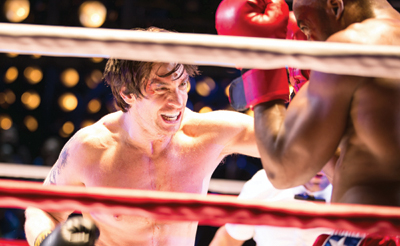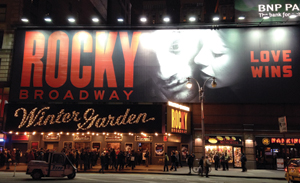Yo, can a musical version of “Rocky” go the distance on Broadway?
That’s the bet of the producers of the show, which opens Thursday at the Winter Garden Theatre — home of earlier mega-hits like “Cats” and “Mamma Mia.”
 |
Andy Karl plays the title role in “Rocky,” based on Sylvester Stallone’s classic movie boxer.
Photo by: MATTHEW MURPHY
|
With song titles like “My Nose Ain’t Broken,” “Happiness” and “Fight from the Heart,” the musical should appeal to mainstream fans of musical theater. Its investors also hope to reach sports fans and the now-middle-aged loyalists of the original movie from 1976 written by and starring Sylvester Stallone.
Back in 1976, many championship boxing matches had a maximum duration of 15 rounds — just like the bout between Rocky Balboa and Apollo Creed that is the climax of the movie and is the most talked-about aspect of the musical (more on that later). So, in the spirit of that fight, here are 15 rounds of news and observations of the theatrical version of “Rocky.”
Sports sponsorship: Although the producers know the play’s primary target audience is the musical theater fan, they also are attempting to reach sports fans around New York. A local “prime rotator” package with ESPN was purchased, providing the show with advertising during breaks in “SportsCenter,” games and other programming across ESPN’s networks seen by New York viewers. They also struck a deal with
 |
The show opens Thursday on Broadway, long unkind to sports.
Photo by: CHRISTOPHER BOTTA / STAFF
|
the CBS affiliate in New York for the sponsorship of local coverage of the NCAA men’s basketball tournament. “March Madness, brought to you by ‘Rocky’ on Broadway” will be seen in bumpers in and out of tournament games.
“Those deals are unusual for a Broadway musical,” said Michele Groner, vice president of sales and marketing for Stage Entertainment, the production company for the show. “There is some crossover between sports fans in New York and households going to live theater. A big part of that demographic is married couples with high incomes. If they can afford a ticket to a live sporting event, they can for a Broadway show.”
The economics: Tickets range in price from $79 to $143, typical for Broadway musicals. The show cost $16.5 million to produce. Two weeks ago, it grossed $551,300 for seven preview performances (which come before the critics’ reviews are published after opening night). That gross was just 43 percent of the maximum amount if every seat were sold at full price for all performances at the 1,500-seat Winter Garden Theatre. “Rocky” needs positive reviews after its official opening night performance Thursday, along with strong word-of-mouth, to be profitable and have a long run.
Digital advertising: To get a better read on potential ticket-buyers, Groner has been working with Quantcast, a San Francisco-based digital company that specializes in audience measurement. Quantcast is helping the marketers of “Rocky” identify potential ticket buyers who should be advertised to digitally. The desired result? As one example, this reporter — a fan of both sports and theater — is now constantly seeing ads for “Rocky” when visiting sports and entertainment websites.
The target audience: Said Groner, “Normally with a musical, you’re targeting women age 35 to 65. We’re trying to also find that male equivalent. Most Broadway shows don’t do that, but between the ‘Rocky’ brand and the sports element, there’s a potential audience out there that we have to tap.”
A real underdog: In the 150-year history of Broadway, only two sports-themed musicals have had true, long-run success. One was “Damn Yankees,” which opened in 1955. It ran for 1,019 performances, was made into a movie in 1958, was revived on Broadway, and remains popular in community theaters. The lesser-known “Good News,” about a love affair between a college football player and his tutor, opened in 1927 and had 557 performances.
Recent history has a “bomb”: Two weeks ago, the non-musical “Bronx Bombers” closed on Broadway after just 60 performances, including 31 previews. During the run of the Yankees-themed play written by Eric Simonson (the successful “Lombardi” in 2010, the unsuccessful “Magic/Bird” in 2012), it made just 23 percent of its potential gross in the 768-seat Circle in the Square Theatre. The “Rocky” producers do not seem concerned, however, about any correlation between “Rocky” and the failure of sports plays. Stallone said “Rocky” is not a boxing tale but rather a love story about Rocky and Adrian and the obstacles they overcome.
Klitschko connection: Wladimir and Vitali Klitschko, the boxing brothers from Ukraine, co-produced (with Stallone) the show’s first production when it debuted in Hamburg, Germany, in November 2012 as “Rocky — Das Musical,” which was performed in German. While that production is still running, the Klitschko brothers are not investors in the Broadway version.
Stallone’s role: Stallone, the writer of the original “Rocky” and its five sequels (which brought in more than $1 billion at the box office) is credited as a co-author (with Thomas Meehan) of the book of the musical. After the show’s first preview performance on Feb. 14, the 67-year-old Stallone took the stage after the curtain calls and told the audience, “I was born about nine blocks from here. It only took me 67 years to get here. Yo, New York, I love ya!”
No Gatorade on stage: The only product placement in the show is with the boxing equipment, from century-old brand Everlast, which is a sponsor of the show. The creative team decided that since the show takes place in the mid-1970s, few potential sponsors would see any benefit from having old logos of their products in the play.
Same for networks: There are also no major networks seen on stage, just mythical television stations.
Show tunes: Have no fear, “Rocky” fans. Although the musical has more than a dozen new songs by the veteran Broadway composing team of Stephen Flaherty and Lynn Ahrens (“Ragtime,” “Once on This Island”), it also features the iconic “Gonna Fly Now” theme from the original movie, as well as “Eye of the Tiger” from “Rocky III.”
Pitching to the sports press: Groner understands the challenge. “When people hear the words ‘Rocky’ and ‘musical,’ they may roll their eyes,” said Groner, who worked on “The Lion King” on Broadway for 10 years. “A lot of the press that we’re doing sends the message, ‘We promise you: ‘Rocky’ is not going to box and tap-dance at the same time.’” Recent feature stories in magazines like the New Yorker and Entertainment Weekly have stressed the physicality of the show.
About the fighting: In staging the climactic match between Balboa and Creed, director Alex Timbers and co-choreographer Steven Hoggett were not influenced by the first film, but rather by “Rocky II.” During a break in rehearsals last week, Hoggett said, “The fight sequence at the end of ‘Rocky II’ is brutal and intense. We looked at that fight as the inspiration for the finale.” Hoggett said the initial “choreography” of the fight took one week to plan but an additional five weeks of rehearsals until the creative team was satisfied with how it looked.
Turning actors into boxers: When actors auditioned last summer for the roles of the boxers at Mickey’s gym, those surviving the first cuts were asked to spend time at boxing gyms to learn stances and punching techniques. “When we started rehearsals a few months ago, we needed that kind of training already in place for the actors getting the roles,” Hoggett said. “You can’t fake being a boxer. On a stage, you can tell in five seconds if someone is not a boxer. The guys put in a lot of work to be authentic, and it has paid off.”
The grand finale: It’s a coup de theater along the lines of the falling chandelier in “Phantom of the Opera” or the helicopter in “Miss Saigon.” With 20 minutes left in the musical, patrons in the first eight rows with tickets marked “golden circle” are asked to leave their seats and take the stage. A boxing ring is lowered from the rafters and placed over the now-vacated seats. The Balboa-Creed title fight is conducted in the orchestra of the theater, with fans on bleachers on the stage. At a recent preview performance, the majority of the crowd stood and cheered throughout the entire fight.
“It was an audacious idea by our director to take the ring deeper into the theater,” Hoggett said. “Alex felt that one of the great things about boxing is that, no matter how much you pay for your ticket, there is a kind of equality, because a match is seen from all four sides. It was important for us to stage the fight with fans all around the ring. In my opinion, it was a stroke a genius.”
It also is the kind of moment that could build word-of-mouth. The producers have decided not to promote the big moment in the show’s marketing campaigns.
“We don’t plan on talking about it, even though we know everyone leaving the theater will,” said Groner, pointing out that “Phantom” and “Miss Saigon” had similar strategies with their epic scenes. “If the theatergoer wants to tweet about it and tell all their friends, that would make us very happy.”



















